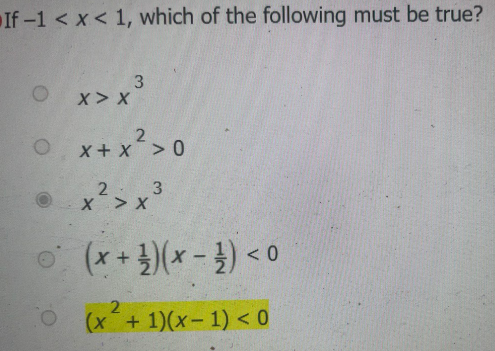Events & Promotions
|
|

GMAT Club Daily Prep
Thank you for using the timer - this advanced tool can estimate your performance and suggest more practice questions. We have subscribed you to Daily Prep Questions via email.
Customized
for You
Track
Your Progress
Practice
Pays
Not interested in getting valuable practice questions and articles delivered to your email? No problem, unsubscribe here.
- Nov 22
11:00 AM IST
-01:00 PM IST
Do RC/MSR passages scare you? e-GMAT is conducting a masterclass to help you learn – Learn effective reading strategies Tackle difficult RC & MSR with confidence Excel in timed test environment - Nov 23
11:00 AM IST
-01:00 PM IST
Attend this free GMAT Algebra Webinar and learn how to master the most challenging Inequalities and Absolute Value problems with ease. - Nov 25
10:00 AM EST
-11:00 AM EST
Prefer video-based learning? The Target Test Prep OnDemand course is a one-of-a-kind video masterclass featuring 400 hours of lecture-style teaching by Scott Woodbury-Stewart, founder of Target Test Prep and one of the most accomplished GMAT instructors.
Kudos
Bookmarks
E
Be sure to select an answer first to save it in the Error Log before revealing the correct answer (OA)!
Difficulty:
 65%
(hard)
65%
(hard)
Question Stats:
64% (01:47) correct 36%
(01:46)
wrong
36%
(01:46)
wrong  based on 1246
sessions
based on 1246
sessions
History
Date
Time
Result
Not Attempted Yet
If \(-1 < x < 1\), which of the following must be true?
A. \(x > x^3\)
B. \(x + x^2 > 0\)
C. \( x^2 > x^3\)
D. \((x+\frac{1}{2})(x-\frac{1}{2}) < 0\)
E. \((x^2+1)(x-1) < 0\)

Screenshot 2024-02-19 112719.png [ 343.83 KiB | Viewed 14106 times ]
A. \(x > x^3\)
B. \(x + x^2 > 0\)
C. \( x^2 > x^3\)
D. \((x+\frac{1}{2})(x-\frac{1}{2}) < 0\)
E. \((x^2+1)(x-1) < 0\)
Attachment:
Screenshot 2024-02-19 112719.png [ 343.83 KiB | Viewed 14106 times ]
Kudos
Bookmarks
gmatophobia
The "must be true" condition implies that the correct option must hold true for all possible values of x. Substituting x = 0 quickly reveals that only options D and E hold true. Substituting 3/4 shows that only E remains.
Answer E.
Alternatively, we could notice that since \(x^2 + 1\) is always positive, we can reduce it in \((x^2+1)(x-1) < 0\) to get \(x-1 < 0\), which yields \(x < 1\). Since this is given to be true, then E must be true.
Answer: E.
General Discussion
Kudos
Bookmarks
This question is of the format - If condition, then what MUST be true. In Quant, such questions can be asked in the context of Number Properties or Algebra concepts. In this question, the context is Algebra.
To answer this question comfortably, one needs to completely understand the approach to solve this question. Translating the question statement with the given condition in your words helps to solidify the approach and guards against getting confused in the process of analyzing the choice.
And then one needs to carefully simplify the choices presented – one at a time. So, one clear faltering point is if the student rushes through this processing. In fact, in this question, one needs to process each choice patiently.
Other faltering points in this question include not considering all cases - such as in choice C, failing to consider that x cannot be 0.
Watch the solution and identify which step you faltered at.
To answer this question comfortably, one needs to completely understand the approach to solve this question. Translating the question statement with the given condition in your words helps to solidify the approach and guards against getting confused in the process of analyzing the choice.
And then one needs to carefully simplify the choices presented – one at a time. So, one clear faltering point is if the student rushes through this processing. In fact, in this question, one needs to process each choice patiently.
Other faltering points in this question include not considering all cases - such as in choice C, failing to consider that x cannot be 0.
Watch the solution and identify which step you faltered at.












